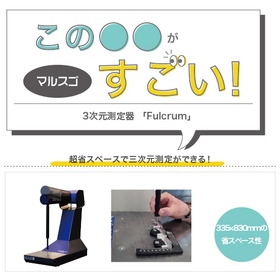Problem-Solving Materials: Utilizing 3D Data Edition 11 | 3D Scanning of Transparent Workpieces
How to reduce post-processing of 3D scans for transparent work? A resource for identifying and solving challenges in the production field.
This document is a series that proposes solutions to various challenges faced in the production field, from identifying issues to finding solutions. In the [3D Data Utilization Edition], we introduce various solutions to manufacturing challenges through the use of 3D data. [Document Overview] The performance of 3D scanners has improved, allowing them to scan "black" and "glossy" workpieces, which were previously difficult for 3D scanners. However, for transparent workpieces, it is necessary to use powder spray for scanning. Using powder spray, however, requires post-processing, which involves: - Fine powder getting into crevices - Careful handling to avoid scratching the workpiece - Being unable to wash it, necessitating wiping it down This makes cleaning tasks cumbersome. Therefore, this document introduces methods to reduce the post-processing steps of 3D scanning. It provides a detailed explanation of the mechanisms and benefits of improving post-processing for scanning transparent workpieces and streamlining the process. *You can download the document using the button below.
basic information
■Vol.11 "3D Scanning of Transparent Objects" - The emergence of 3D scanners that can accommodate various types of objects - Objects that cannot be scanned even with improved 3D scanner performance - Challenges when using spray ■Vol.11-1 "Reduction of Post-Processing Steps for Objects" - Sublimation spray "AESUB blue" for 3D scanning that requires no post-processing - Shortening the post-processing time required for 3D scanning - Are there any residues after sublimation?
Price range
Delivery Time
Applications/Examples of results
Please use this as a tip for those who want to reduce post-processing time after 3D scanning or are considering more efficient operations.
catalog(1)
Download All CatalogsRecommended products
Distributors
【Proposing the latest and standard equipment for manufacturing through a system】 We are the only company in Japan that can provide a comprehensive proposal for all the equipment necessary for manufacturing, including machine tools, CAD/CAM, 3D printers, 3D scanners, and other 3D digital production tools and instruments. 【Peace of mind with technical support after installation】 With our strength in technical support, we can resolve any concerns of users after installation, such as operation assistance, troubleshooting, and maintenance, all through a single point of contact. 【Extensive display of actual machines】 We have various actual machines set up, allowing you to clarify your operational image through demonstrations and tours before making a decision to implement. 【Manufacturer capabilities】 Additionally, if there are no products with the features desired by users, or if there are products with good features but weak sales power, we will leverage our manufacturer capabilities to release them as uniquely planned in-house products.



















































